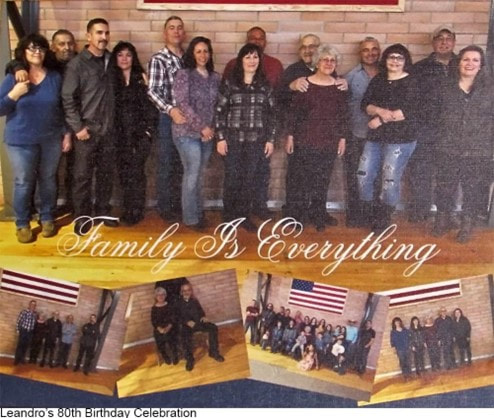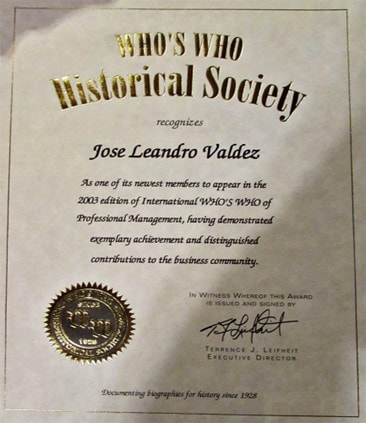|
Interview with Leandro and Vangie Valdez ~ Jessica Rath “Everything has changed so much since I was young! We had no cars, but horses and horse buggies. My Dad did all the farming with horses, he had no tractors.” This is what long-time Coyote resident Leandro Valdez told me when I visited him and his wife recently. I wanted to find out more about Coyote’s past, and they graciously agreed to an interview. When I entered their kitchen, I noticed a prominently placed photo on the wall: It was from Leandro’s 80th-birthday bash at the high school in Gallina, which I had attended too. Hundreds of guests were there! Leandro and his wife Vangie are the third couple from the right; the other six couples are his three daughters and three sons with their spouses. I soon learned that a lot more had changed since the time of horse-buggies. Coyote used to have a highschool – the Charles Lathrop Pack School! Arthur Pack, then-owner of Ghost Ranch, donated the funds to build the school, and he named the school in honor of his father. He sold Ghost Ranch to the Presbyterian Church in 1955 and, together with his wife Phoebe, was the original donor for the Presbyterian Hospital in Espanola. When Leandro graduated from highschool in 1956, there were lots of children attending the school, some of them were bussed from grade schools in Youngsville and Cañones. “Every Sunday we had baseball games. There was a team in Coyote, a team in Gallina, one in Cañones; and they even had rodeos in Gallina”, Vangie told me. “There used to be over 100 kids just here! Now, kids come from Lindrith, Cañones, Youngsville, etc. to go to the high school in Gallina, but altogether there are less than one hundred. People don’t want to have kids any more. Plus, people moved away because there’s no work here.” Before, people were working for the lumber companies, and there was lots of logging in this area. There used to be a lumber mill in Gallina, and another one between Coyote and Youngsville; a lot of people would go to work there. “When I went to school in Gallina, there were lots of students – black students, white students. The parents would move to Gallina from all over the States, there was so much work because of the lumber mills”, Vangie said. Also, there were six stores in the area, not counting the two in Youngsville. Two in Coyote, two in Arroyo del Agua, two in Mesa Poleo. And across from the post office there used to be a restaurant. I asked Leandro why the work stopped: “Because of environmental protection – there were endangered species such as the spotted owl and salamanders, things like that. So they stopped the Forest Service from cutting timber. Now, they can cut only a small amount, to thin the forest out. At that time, the lumber industry, the Forest Service, and the schools were the main employers here.” Leandro worked for the Forest Service some 25 years, until he retired. Before that, he also worked in the logging industry for several years. And before that, after he graduated from highschool, he joined the military and was sent to Korea. The US Army was stationed there to protect South Korea and the Demilitarized Zone (DMZ). He was 17 years old and stayed for ten months. A tragic accident which killed his brother who was 15 at the time forced him to get a hardship discharge and return home. His brother went on a school picnic at the Chama River near where the dam is now (which hadn’t been built yet). The river was about 12 feet below the road; the river itself was about 4 feet deep but had risen all the way to the road – 16 feet deep. The bus went around a corner, and the road had already been swept away – his brother drowned. Leandro returned to Coyote in 1958 and finished his tour with the military as a National Guard, even after he and Vangie got married in 1961; every summer he had to go for several weeks. He started working for the Forest Service, and he learned to work the pumper unit; there was no Fire Department in Coyote yet. He had a crew of fire fighters, and they would travel all over the US for the Forest Service, wherever there were fires. Montana, Wyoming, Washington, Arizona, Tennessee, Kentucky – he was the crew boss. In 1974 he became Fire Manager Officer, because he had experience with the administrative part. He had taken a correspondence course about computers; that helped him when he worked for the Forest Service. “At first, they said: we won’t have any computers here! But two years later, they had them” Leandro told me. Everybody had to learn for themselves how to operate them. The correspondence course helped him. I was curious to know how the two had met! It happened at a wedding dance in Gallina; Leandro and Vangie’s brother had already been close friends. Leandro asked her for a dance, and after that, they knew they’d be together. Vangie said that her Mom was very strict; for example, when Leandro wanted to take her to a drive-in movie in Regina, she was allowed to go only if her brother would come along too – as chaperone. Yes, there was a drive-in movie theater in Regina! There used to be a lot of entertainment here! After many people moved away, the stores would close, one after another. The store across from the post office (the only store that was still open when I moved here in 2009) used to have a laundromat. But then people bought their own washers and dryers; people didn’t use the laundromat any more and this store also closed eventually. Recently somebody bought the store again. But to make the gas station work would require a lot of money – new tanks and new pumps, because what’s there is outdated. If it would be a 24-hours gas station, it may work. Right now, people have to drive to Abiquiú or to Regina to buy gas. It may be convenient to be able to get gas in Coyote; however, if it’s a lot more expensive, people might think twice. In 2001, the New Mexico Magazine published a lovely article about Leandro and his way of life, written by Alice McSweeney. I didn’t ask how she knew about him, we had already chatted for almost two hours. But there’s no question that he and Vangie can look back at a rich, fascinating, fulfilled life. I’m glad that their memories and the history of this region is being preserved in different ways.
1 Comment
Robin hardie
3/10/2023 10:12:07 am
Thank you so much for this interesting article. I love knowing about local…everything! Thank you!
Reply
Your comment will be posted after it is approved.
Leave a Reply. |
Submit your ideas for local feature articles
Profiles Gardening Recipes Observations Birding Essays Hiking AuthorsYou! Archives
September 2025
Categories
All
|




 RSS Feed
RSS Feed